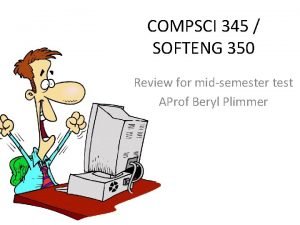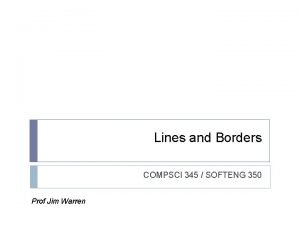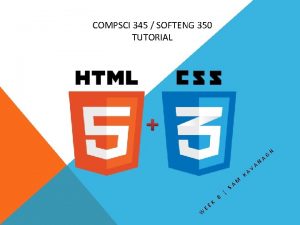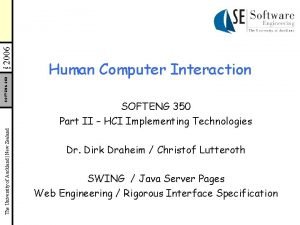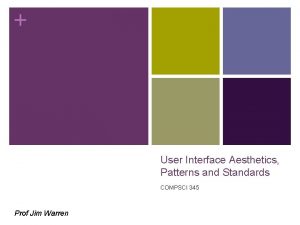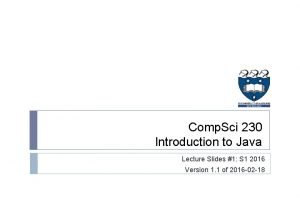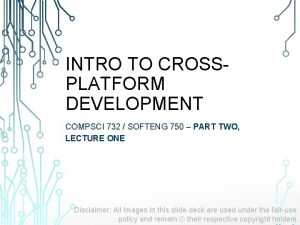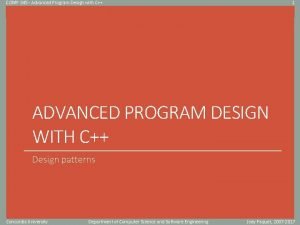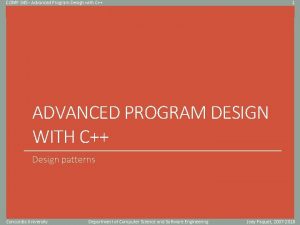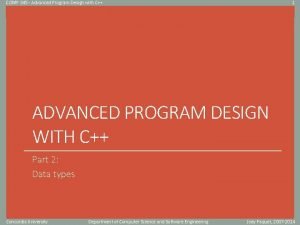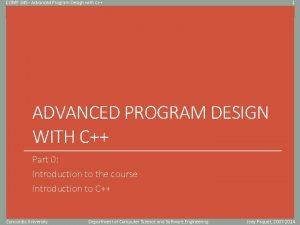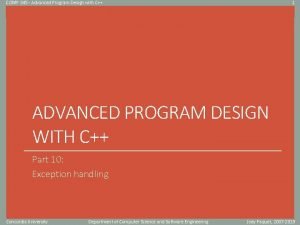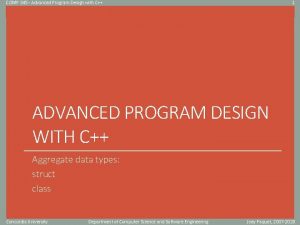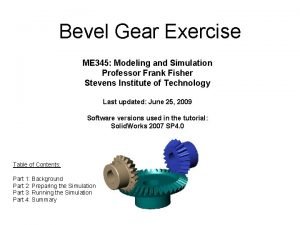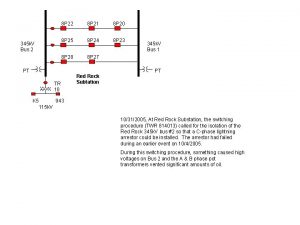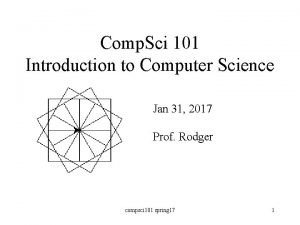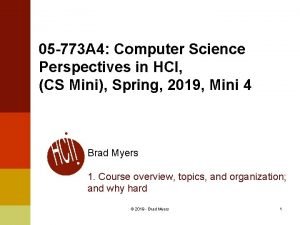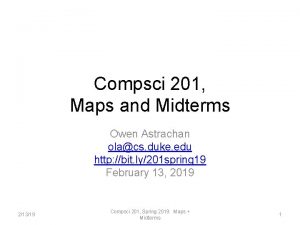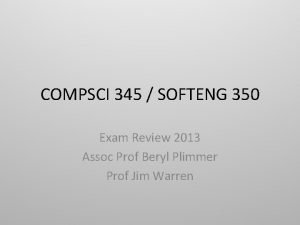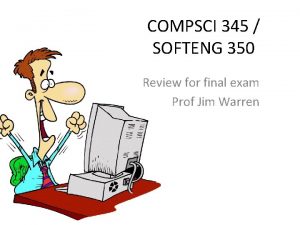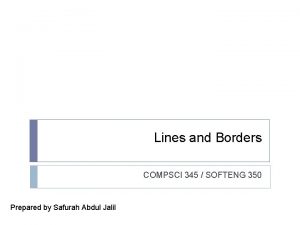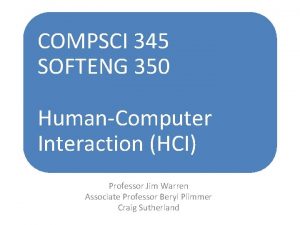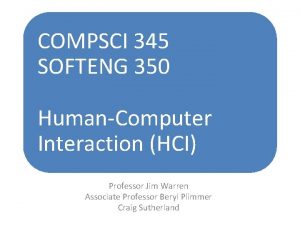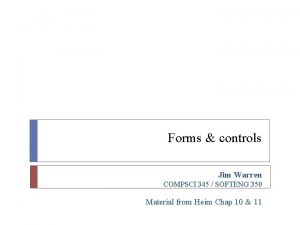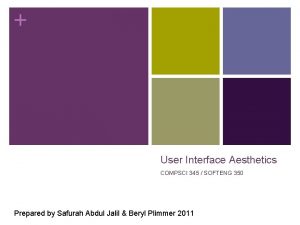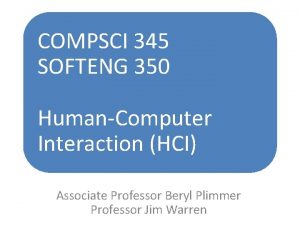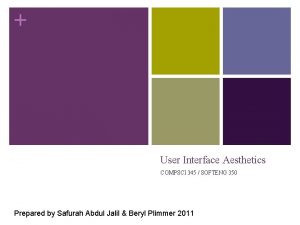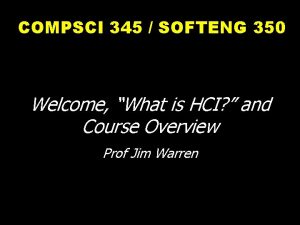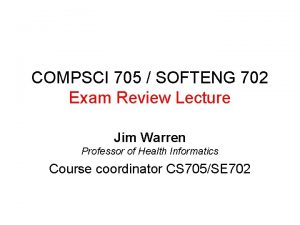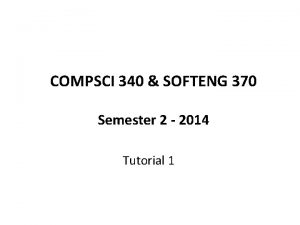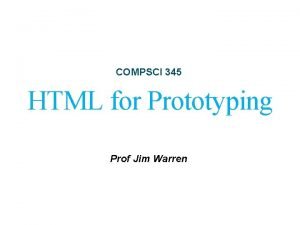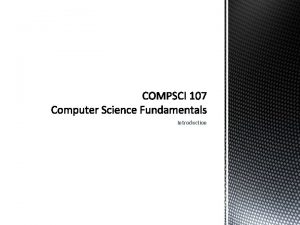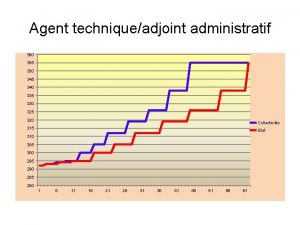COMPSCI 345 SOFTENG 350 Review for midsemester test






























- Slides: 30

COMPSCI 345 / SOFTENG 350 Review for mid-semester test AProf Beryl Plimmer

Test review lecture format • Review the learning objectives of each of the lectures and assignment 1 • Ask specific questions as we go

L 1: Introduction • Meet the lecturers • Be able to define HCI • Be able to articulate the importance of HCI to the success of modern software • Be aware of the course structure and organisation • Appreciate the role of the assessable components in your learning of HCI

L 2: Discovery • To develop a set of skills for systematic analysis of a problem domain to discover HCI issues and requirements • To understand perspectives on data collection including types of stakeholders • To be able to collect data by interviews, focus groups and questionnaires 1 -4

L 2 Discovery • Stakeholders – Primary, secondary, facilitator, indirect • Filters – Physical, cultural, functional, informational • Methods of collection – Observational – direct and indirect – Elicitation - direct (structure and unstructured) indirect (open ended, constrained

L 3: Discovery 2 • • Task Analysis Storyboarding Use Cases Primary Stakeholder Profiles

L 3: HTAs – Assignment Answer

L 4: Usability evaluations • Be able to define usability • Be able to describe aspects and measures of usability • Appreciate that usability depends on context • Be able to compare the major types of usability evaluation – Heuristic evaluation – Usability tests – Analytical performance measures (Fitts’ and Hick. Hyman’s Laws) Usability Evaluations 8

L 4 Usability Evaluations • Usability factors – Fit for use, ease of learning, efficiency of use, memorability, error frequency and severity, subjective satisfaction • Types of usability evaluations – Heuristic evaluations – Performance measures – Fitts’ Law, Hick-Hyman Law ; KLM and GOMS – Usability studies – Comparative studies

L 5 Heuristic evaluations To be aware of a range of heuristic evaluation options appropriate to the analysis and design phase – In particular well known heuristics of usable systems • Nielsen’s heuristics • Schneiderman’s rules • To understand the difference evaluation challenges of early prototypes with limited functionality

L 5 Heuristic Evaluations • Accuracy? • Heuristic Guidelines – Schneiderman’s & Nielson’s • Evaluating Prototypes – Wizard of Oz – Semi functional prototypes

L 6: Usability testing • Be able to articulate why and when to do usability testing • Be able to develop usability testing plans (continues next lecture) • Be able to write usability test reports (continues next lecture) Usability Evaluations 12

L 6 Usability Testing • • When to test Why test Usability testing tools and facilities Making use of what you learn

L 7: Usability testing – planning & reporting • Be able to develop usability testing plans • Be able to write usability test reports • Understand the nature of human research ethics requirements when conducting studies on humans Usability Evaluations 14

L 7 Usability test details • • • Participants Tasks Questionnaires Analysis Report Process – plan, script, ethics, professionalism

Half time entertainment • Computer says NO (little Britian) • https: //www. youtube. com/watch? v=s. X 6 h. Mh. L 1 Ys. Q • https: //www. youtube. com/watch? v=AJQ 3 TM-p 2 QI • There are lots more of these.

L 8: Conceptual design • To appreciate role of Conceptual Design prior to Physical Design • To be equipped with a set of methods for Conceptual Design – Particularly personas and scenarios 1 -17

L 8: Conceptual Design • Structuring the information space – Card sorts, semantic networks etc • Personas – Created from …. – Contain…. • Scenarios – Created from … – contain

L 9: Physical design • To appreciate the value of prototyping (especially paper prototyping) to the design process • To be aware of the different types and options in prototyping and be able to choose the most appropriate ones for specific design problems • To be able to develop useful prototypes for eliciting user feedback 1 -19

L 9 Physical Design • Making paper prototypes • Advantages and disadvantages of paper prototypes • Other non functional (or semi functional) prototyping tools – Advantages and disadvantages • Depth versus breath prototyping – Wire framing – Patterns

L 9: Design principles 1 • To be able to apply design principles in the context of user interface design tasks • To be able to characterise key design principles for effectiveness and efficiency • To be able to conceptualise design principles in terms of an interaction framework 1 -21

L 9 Design principles • Framework for design principles • Key design principles – comprehensibility, learnability, effectiveness, efficiency • Effectiveness/Usefulness – Utility, Safety, Flexibility, Stability • Efficiency/Usability – Simplicity, Memorability, Predictability, Visibility

L 11 Visual Perception • What are the two stages of the visual system? • How do luminance and colour effect visual perception? • What is the difference between central and peripheral vision? • How do we read?

L 11 Visual Perception • Stages of vision – Physical receptors, processing and interpretation • Physical – Cones and rods – Central and peripheral – Luminance and colour – Detail and movement • Interpreting – Context and clues – Reading

L 12 Aesthetics • • What is aesthetics? What are the principles of aesthetics? Why is aesthetics important to HCI? Do people agree on aesthetically pleasing?

L 12 Aesthetics • Aesthetically pleasing interface is perceived as – More usable, trustworthy and error tolerance is increased • Principles – Balance, emphasis and unity • Components – Foreground: text, colour & images, lines and borders, forms and controls – Background

L 13 Grouping • When and where is grouping critical in UI design? • What techniques can be used to sort things into groups? • How can you visualize the groups? • What visual clues can you use to indicate things belong together or apart?

L 13 Grouping • Information architecture – Hierarchy, network, trees • Grouping on screen Gestalt principles – Proximity – Similarity – Common Fate – Closure – Good Continuity – Area – Symmetry – Surroundedness – Prägnanz

Assignment 1 • To apply usability testing methods – Become familiar with heuristic evaluation tools • HTAs • Check list and templates – Reflect on the content of a good user testing plan • Components, process

Finally • Do your revision • Ask questions and discuss via Piazza • Relax – you will perform better – But not too much you also need a bit of stress to focus – Smile
 Compsci 345
Compsci 345 Compsci 345
Compsci 345 Softeng 350
Softeng 350 Softeng 350
Softeng 350 Nuremberg code
Nuremberg code Compsci 345
Compsci 345 Compsci 111 review
Compsci 111 review Compsci 111g
Compsci 111g Compsci 230 review
Compsci 230 review Softeng 750
Softeng 750 Test 345
Test 345 Comp 345
Comp 345 Comp 345
Comp 345 Comp 345 final
Comp 345 final Byk 333
Byk 333 Comp345
Comp345 Comp 345
Comp 345 Comp 345
Comp 345 Bienvenidos himno
Bienvenidos himno Gear exercise
Gear exercise 345 king william street adelaide
345 king william street adelaide Hbpc-345
Hbpc-345 A-345-k
A-345-k Compsci 732
Compsci 732 Damir azhar
Damir azhar Duke compsci 101
Duke compsci 101 Master of professional studies in data science
Master of professional studies in data science Compsci 732
Compsci 732 Compsci 773
Compsci 773 Compsci 201
Compsci 201 Duke compsci 201
Duke compsci 201
